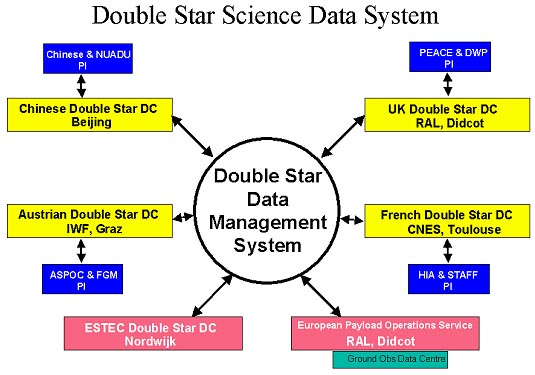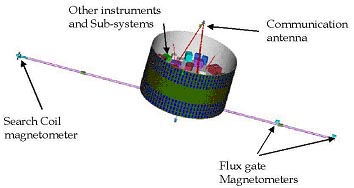The Cluster Legacy - Double Star
The Cluster Legacy
Each Double Star spacecraft carries eight scientific instruments, with half of the overall number provided by European institutions. The key aspect of Europe's participation in Double Star was the inclusion of seven instruments identical to those flying on the Cluster spacecraft, plus one extra instrument provided by the National University of Ireland. The first European instruments to be flown on Chinese satellites are accompanied by a further eight experiments provided by Chinese institutes.
The fact that most of the European science payload was derived from Cluster 'spares' made it possible to prepare and launch them on Double Star during the limited operational lifetime of ESA's quartet.
"By flying experiments identical to those on Cluster, we have been able to reduce costs and development time," explained Bodo Gramkow. "This minimised the risks and helped us to ensure that we would be able to meet the spacecraft development schedule."
Table 1: Double Star Scientific Payload
|
Equatorial Double Star (TC-1) |
Polar Double Star (TC-2) |
||
|
Instruments |
PI |
Instruments |
PI |
|
Active Spacecraft Potential Control (ASPOC) |
K. Torkar, IWF, Graz, Austria |
Neutral Atom Imager (NUADU) |
S. McKenna-Lawlor, Ireland U., Ireland |
|
Fluxgate Magnetometer (FGM) |
C. Carr IC, UK |
Fluxgate Magnetometer (FGM) |
T. Zhang, IWF, Austria |
|
Plasma Electron and Current Exp. (PEACE) # |
A. Fazakerley, MSSL, Dorking, UK |
Plasma Electron and Current Exp. (PEACE) # |
A. Fazakerley, MSSL, Dorking, UK |
|
Hot Ion Analyzer (HIA), sensor 2 of CIS |
H. Reme, CESR, Toulouse, France |
Low Energy Ion Detector (LEID) * |
Q. Ren and J.B. Cao, CSSAR,China |
|
Part of Spatio-Temporal Analysis of Field Fluct.(STAFF) + Digital Wave processor (DWP) |
N. Cornilleau/H. Alleyne, CETP, Velizy, France and Sheffield U. UK |
Low Frequency Electromagnetic Wave detector (LFEW) *
|
Z. Wang and J.B. Cao, CSSAR, China |
|
High Energy Electron Detector (HEED) * |
W. Zhang and J.B. Cao, CSSAR, China |
High Energy Electron Detector (HEED) * |
W. Zhang and J.B. Cao, CSSAR, China |
|
High Energy Proton Detector (HEPD) * |
J. Liang and J.B. Cao, CSSAR, China |
High Energy Proton Detector (HEPD) * |
J. Liang and J.B. Cao, CSSAR, China |
|
Heavy ion detector (HID) * |
Y. Zhai and J.B. Cao, CSSAR, China |
Heavy ion detector (HID) * |
Y. Zhai and J.B. Cao, CSSAR, China |
* Instrument built by China
# PEACE includes only one sensor on each spacecraft
|
|
| Artist's Impression: Double Star Payload (or flight config.) |
The European-provided instruments are:
-
Active Spacecraft Control (ASPOC) (PI: K. Torkar, IWF, Austria)- This instrument prevents a build up of positive electrical charge on the spacecraft by emitting ions of indium into space. (TC-1 only)
· Hot Ion Analyser (HIA) (PI: H. Reme, CESR, France) - One of the spare sensors from the CIS instrument on Cluster, this instrument analyses the distribution of ions in the surrounding space plasma during each four-second spin of the spacecraft. (TC-1 only) - Fluxgate Magnetometer (FGM) (PIs: C. Carr, IC, UK and T. Zhang, IWF, Austria) - Two magnetometers attached to a 3.5 metre boom measure the local magnetic field and magnetic waves. They are able to make high resolution measurements with up to 22 samples per second. (TC-1 and 2)
- NeUtral Atom Detection Unit (NUADU) (PI: S. McKenna-Lawlor, Nat. Univ. of Ireland) - Based on an instrument flying on ESA's Mars Express mission, this is an advanced particle detector that is designed to monitor energetic neutral atoms in the Earth's magnetosphere and perform imaging of the Earth's Ring Current. (TC-2 only)
- Plasma Electron and Current Experiment (PEACE) (PI: A. Fazakerley, MSSL, UK) - This instrument is designed to measure the density, temperature and velocity of low-to-medium energy electrons. The spare instrument for Cluster has been split into two instruments: one sensor will fly on each Double Star spacecraft. (TC-1 and 2)
- Spatio-Temporal Analysis of Field Fluctuations (STAFF) (PI: N. Cornilleau-Wehrlin, CETP, France) and Digital Wave Processing Experiment (DWP) (PI: H. Alleyne, Sheffield Univ., UK) - A magnetometer on the end of a 3.5 metre long boom looks at waves (rapid variations in the magnetic fields), particularly in regions where the solar wind interacts with the magnetosphere. Low frequency data are analysed on the ground, while the magnetic components of the higher frequency waves are processed on board. It also has a particle correlator that enables variations in the electron population around the spacecraft to be compared with the wave measurements. (TC-1 only)
The European Payload Operations Service (EPOS) at Rutherford Appleton Laboratory in the UK is co-ordinating the scientific operations of the European payload. EPOS is also developing the Double Star data management system (DDMS) that distributes data to the users, and the Double Star quicklook web page (DSDS web) that will display the latest data from both European and Chinese instruments. One of the EPOS tasks is to disseminate planning data about orbit and geomagnetic events in order to facilitate co-ordination with other magnetospheric missions.
Data from the Double Star experiments will be relayed to the Chinese data centre in Beijing via the ESA ground station at Villafranca (Spain) and the Chinese ground stations in Beijing and Shanghai. A dedicated network line has been set up between Villafranca and Beijing to facilitate the transfer of data. The European Space Operations Centre (ESOC) is in charge of collecting the data from Villafranca, while CSSAR is collecting the data at Beijing and Shanghai. Once they have been decompressed and prepared for use, the data will be sent to the Austrian data centre in Graz, where they will be made available for the European PIs (Fig. 6). The PIs will then process the data and send them to the Austrian, French and UK data centres for distribution to the scientists.
 |
|
The Double Star Science Data System |
It is envisaged that a series of joint workshops and publications will result from this close collaboration. Meanwhile, the first announcement of opportunity to select Guest Investigators for the Double Star mission was issued in June 2003, with a "very positive reaction" from the European scientific community, according to Escoubet. Eight proposals were selected (see Table 2), covering various aspects of magnetospheric physics and co-ordinating Double Star and Cluster measurements.
Table 2: Selected Guest Investigators
|
Guest-Investigator |
Investigation |
|
D. Boscher, Onera, Toulouse, F |
Radiation Environment Research from Multiple Monitors using Double Star |
|
S. Bucher, IRF-U, S |
Magnetosphere-ionosphere coupling, field-aligned currents and ion flow near the dayside cusp and auroral zone using ground-based, double star and Cluster |
|
M. Dunlop, RAL, UK |
Co-ordinated Cluster- DSP measurements in the cusp and at the magnetopause |
|
J. Jahn, SWRI, USA |
Multi-Spacecraft Energetic Neutral Atom Observations of Magnetospheric Processes |
|
F. Pitout, ESTEC, NL |
Double Cusps and Reconnection Hypotheses |
|
T. Pulkinen, FMI, Finland |
Global Understanding of Storms in the Inner Magnetosphere |
|
S. Shwartz, QMW, UK |
Kinetic Processes and Conditioning in the Dayside Magnetosheath and Equatorial Geomagnetic Tail |
|
J. Wild, Leicester U., UK |
A coordinated in-situ and remote-sensing investigation of magnetosphere-ionosphere coupling exploiting Double Star, Cluster and ground-based experiments" |
- Removed a total of (15) align=center.
- Removed a total of (4) border attribute.
- Removed a total of (4) cellpadding attribute.
- Removed a total of (4) cellspacing attribute.








































 Sign in
Sign in
 Science & Technology
Science & Technology
